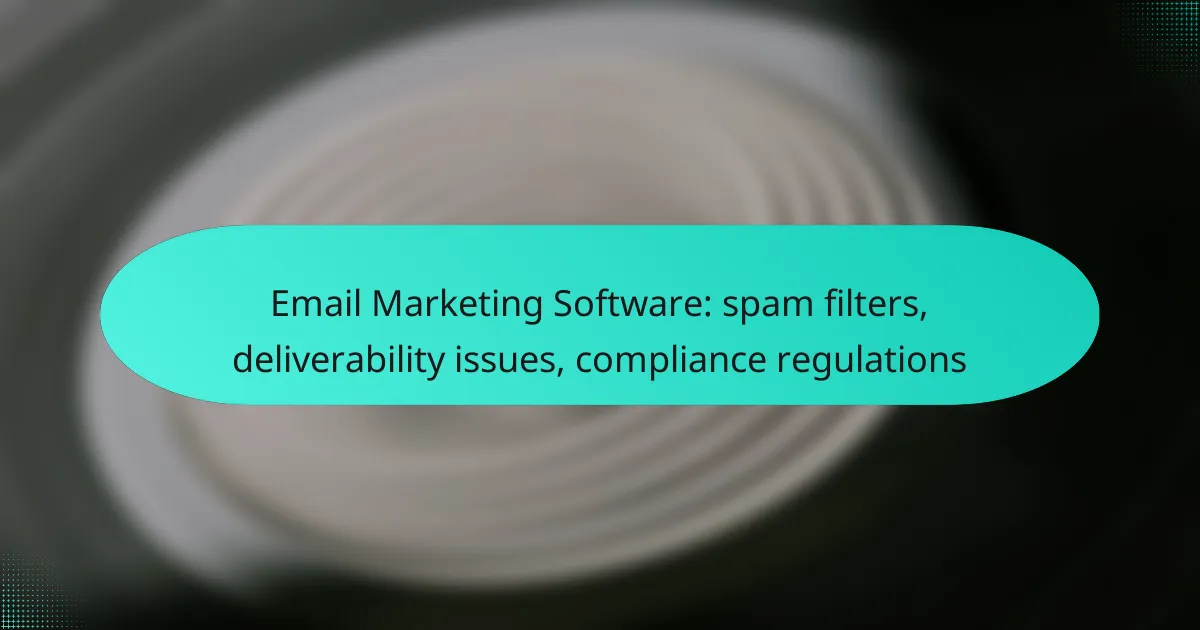Email marketing software plays a crucial role in navigating spam filters and deliverability issues, ensuring that your messages reach their intended audience. By understanding common spam triggers and adhering to compliance regulations like the Canadian Anti-Spam Legislation (CASL), businesses can enhance their email strategies. Implementing best practices such as using verified email lists and authenticating domains is essential for maintaining a positive sender reputation and achieving successful email campaigns.

How to improve email deliverability in Canada?
Improving email deliverability in Canada involves ensuring that your emails reach the intended inboxes without being filtered as spam. Key strategies include using verified email lists, authenticating your domain, monitoring your sender reputation, optimizing your email content, and engaging with your subscribers.
Use verified email lists
Using verified email lists is crucial for enhancing deliverability. This means regularly cleaning your lists to remove invalid or inactive addresses, which can hurt your sender reputation. Consider using email verification tools to ensure that your contacts are legitimate and engaged.
Additionally, focus on building your list organically through opt-in methods. This not only improves the quality of your list but also increases the likelihood of higher engagement rates, which positively impacts deliverability.
Authenticate your domain
Domain authentication is essential for establishing trust with email service providers. Implement protocols such as SPF (Sender Policy Framework), DKIM (DomainKeys Identified Mail), and DMARC (Domain-based Message Authentication, Reporting & Conformance) to verify that your emails are genuinely from your domain.
These authentication methods help prevent spoofing and phishing attacks, which can lead to your emails being marked as spam. Ensure that your DNS records are correctly configured to support these protocols.
Monitor sender reputation
Monitoring your sender reputation is vital for maintaining high email deliverability. This reputation is influenced by factors such as bounce rates, spam complaints, and engagement levels. Use tools to track your reputation score, which can vary between email service providers.
Regularly review your email performance metrics and adjust your strategies accordingly. A good sender reputation can significantly increase the chances of your emails landing in the inbox rather than the spam folder.
Optimize email content
Optimizing your email content is key to engaging your audience and improving deliverability. Focus on creating relevant, personalized content that resonates with your subscribers. Avoid using spammy language, excessive images, or misleading subject lines that could trigger spam filters.
Additionally, ensure that your emails are mobile-friendly and visually appealing. A well-structured email with clear calls to action can enhance user engagement and reduce the likelihood of being marked as spam.
Engage with subscribers
Engaging with your subscribers helps build a loyal audience and improves deliverability. Encourage feedback and interaction through surveys or polls to understand their preferences better. This engagement can lead to higher open and click-through rates, which positively influence your sender reputation.
Consider segmenting your audience based on their behavior and preferences, allowing for more targeted and relevant communications. Regularly sending valuable content will keep your subscribers interested and less likely to unsubscribe or mark your emails as spam.

What are common spam filter triggers?
Common spam filter triggers can prevent your emails from reaching recipients’ inboxes. Understanding these triggers is essential for improving email deliverability and ensuring compliance with regulations.
Excessive use of promotional language
Using too much promotional language, such as “free,” “guaranteed,” or “limited time offer,” can raise red flags for spam filters. Aim for a balanced tone that provides value without sounding overly sales-focused.
To avoid this pitfall, limit the use of promotional phrases and focus on delivering informative content. A good rule of thumb is to keep promotional language to a minimum, ideally under 10% of your total email content.
High image-to-text ratio
A high image-to-text ratio can trigger spam filters, as many spam emails rely heavily on images without sufficient text. Aim for a balanced mix of images and text to ensure clarity and engagement.
As a guideline, maintain at least 60% text and 40% images in your emails. This helps convey your message effectively while reducing the risk of being flagged as spam.
Inconsistent sender information
Inconsistent sender information, such as varying sender names or email addresses, can confuse spam filters and recipients alike. Consistency builds trust and improves deliverability.
Use a recognizable sender name and email address across all communications. This not only helps in avoiding spam filters but also enhances brand recognition among your audience.
Spam complaints from recipients
Spam complaints occur when recipients mark your emails as spam, which can negatively impact your sender reputation. High complaint rates can lead to your emails being filtered out by ISPs.
To minimize complaints, ensure that your emails are relevant and valuable to your audience. Regularly clean your email list to remove inactive subscribers and provide clear options for recipients to unsubscribe if they choose.

How to comply with Canadian anti-spam regulations?
To comply with Canadian anti-spam regulations, businesses must follow the Canadian Anti-Spam Legislation (CASL), which emphasizes obtaining consent, providing clear unsubscribe options, and maintaining accurate sender identification. Adhering to these guidelines helps ensure that email marketing efforts are legal and effective.
Obtain explicit consent
Obtaining explicit consent means that you must have permission from recipients before sending them commercial emails. This consent should be clear, informed, and given voluntarily, which can be achieved through sign-up forms or opt-in checkboxes on your website.
For example, when a user subscribes to your newsletter, ensure that the form explicitly states what they are consenting to receive. Avoid pre-checked boxes, as they do not constitute valid consent under CASL.
Provide clear unsubscribe options
Every commercial email must include a clear and easy way for recipients to unsubscribe from future communications. This option should be visible and functional, allowing users to opt-out without unnecessary steps.
For instance, including an unsubscribe link at the bottom of each email is a common practice. Make sure that the process is straightforward, ideally requiring only a single click to complete the unsubscription.
Maintain accurate sender identification
Accurate sender identification involves clearly identifying who is sending the email, including the sender’s name and contact information. This transparency builds trust and is a legal requirement under CASL.
Ensure that your emails display a recognizable sender name and an email address that recipients can use to contact you. This information should be easy to find, typically located in the header or footer of the email.

What tools can help with email marketing compliance?
Several tools can assist with email marketing compliance by ensuring adherence to regulations and improving deliverability. These tools help manage consent, track compliance with anti-spam laws, and optimize email campaigns to avoid spam filters.
Mailchimp compliance features
Mailchimp offers various compliance features designed to help users meet legal requirements. It includes tools for managing subscriber consent, such as double opt-in options, ensuring that users explicitly agree to receive emails.
Additionally, Mailchimp provides templates that comply with GDPR and CAN-SPAM regulations, making it easier to create compliant marketing materials. Users can also access reports that track engagement metrics, which can help identify potential deliverability issues.
Constant Contact compliance tools
Constant Contact includes built-in compliance tools that assist with managing subscriber lists and consent. The platform allows users to segment their audience based on consent status, ensuring that only those who have opted in receive marketing emails.
Moreover, Constant Contact offers resources and best practices for adhering to email marketing laws, including customizable email templates that comply with regulations. Users can also track unsubscribe rates and engagement to enhance their compliance efforts.
Sendinblue consent management
Sendinblue features robust consent management tools that help businesses comply with GDPR and other regulations. Users can create customized subscription forms that clearly outline consent options, allowing for transparent communication with subscribers.
Additionally, Sendinblue provides a centralized dashboard for managing consent records, making it easier to demonstrate compliance during audits. The platform also includes automation features that help maintain compliance by automatically removing unconsented contacts from mailing lists.

How to analyze email campaign performance?
To analyze email campaign performance, focus on key metrics such as open rates, click-through rates, and conversion rates. These indicators provide insights into how well your emails engage recipients and drive desired actions.
Track open rates
Open rates measure the percentage of recipients who open your email compared to the total number of emails delivered. A typical open rate can range from 15% to 25%, depending on the industry and audience. Monitoring this metric helps you assess the effectiveness of your subject lines and sender reputation.
To improve open rates, consider A/B testing different subject lines and sending times. Avoid spammy language and ensure your emails comply with regulations like the CAN-SPAM Act to maintain a good sender reputation.
Measure click-through rates
Click-through rates (CTR) indicate the percentage of recipients who clicked on one or more links within your email. A healthy CTR generally falls between 2% and 5%. This metric helps you understand how compelling your content and calls-to-action are.
To enhance CTR, use clear and enticing calls-to-action, and ensure your links are easily accessible. Segmenting your audience can also lead to more personalized content, which often results in higher engagement.
Evaluate conversion rates
Conversion rates reflect the percentage of recipients who complete a desired action after clicking through your email, such as making a purchase or signing up for a newsletter. Typical conversion rates can vary widely but often hover around 1% to 3%. This metric is crucial for measuring the overall success of your campaign.
To boost conversion rates, ensure your landing pages align with the email content and provide a seamless user experience. Utilize tracking tools to analyze user behavior and optimize your campaigns based on data-driven insights.
